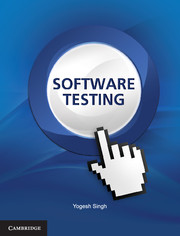Book contents
- Frontmatter
- Contents
- List of figures
- List of Tables
- Preface
- Acknowledgements
- 1 Introduction
- 2 Functional Testing
- 3 Essentials of Graph Theory
- 4 Structural Testing
- 5 Software Verification
- 6 Creating Test Cases from Requirements and Use Cases
- 7 Selection, Minimization and Prioritization of Test Cases for Regression Testing
- 8 Software Testing Activities
- 9 Object Oriented Testing
- 10 Metrics and Models in Software Testing
- 11 Testing Web Applications
- 12 Automated Test Data Generation
- Appendix I
- Appendix II
- Appendix III
- References
- Answers to Multiple Choice Questions
- Index
5 - Software Verification
Published online by Cambridge University Press: 05 November 2012
- Frontmatter
- Contents
- List of figures
- List of Tables
- Preface
- Acknowledgements
- 1 Introduction
- 2 Functional Testing
- 3 Essentials of Graph Theory
- 4 Structural Testing
- 5 Software Verification
- 6 Creating Test Cases from Requirements and Use Cases
- 7 Selection, Minimization and Prioritization of Test Cases for Regression Testing
- 8 Software Testing Activities
- 9 Object Oriented Testing
- 10 Metrics and Models in Software Testing
- 11 Testing Web Applications
- 12 Automated Test Data Generation
- Appendix I
- Appendix II
- Appendix III
- References
- Answers to Multiple Choice Questions
- Index
Summary
Software verification has proved its effectiveness in the software world and its usage is increasing day by day. The most important aspect of software verification is its implementation in the early phases of the software development life cycle. There was a time when people used to say that “testing is a post-mortem activity where testers are only finding the damages already been done and making changes in the program to get rid of these damages.” Testing primarily used to be validation oriented where the program was required for execution and was available only in the later phases of software development. Any testing activity which requires program execution comes under the ‘validation’ category. In short, whenever we execute the program with its input(s) and get output(s), that type of testing is known as software validation.
What is software verification? How can we apply this in the early phases of software development? If we review any document for the purpose of finding faults, it is called verification. Reviewing a document is possible from the first phase of software development i.e. software requirement and analysis phase where the end product is the SRS document.
Verification is the process of manually examining / reviewing a document. The document may be SRS, SDD, the program itself or any document prepared during any phase of software development. We may call this as static testing because the execution of the program is not required.
- Type
- Chapter
- Information
- Software Testing , pp. 230 - 284Publisher: Cambridge University PressPrint publication year: 2011

